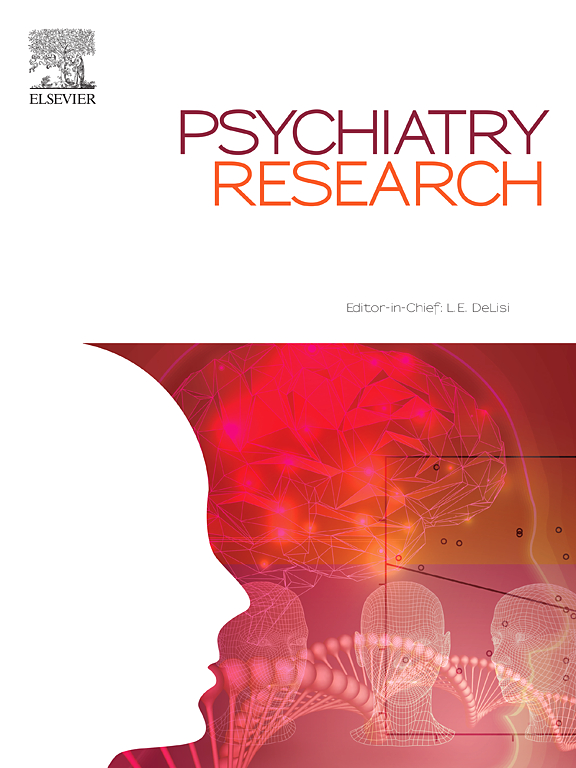护士辅助的数字思维健康项目对产后抑郁症的有效性:一项随机对照试验
IF 4.2
2区 医学
Q1 PSYCHIATRY
引用次数: 0
摘要
背景:产后抑郁症(PPD)是一种普遍存在的心理健康问题,对母亲和婴儿都有严重的不良后果。思考健康计划(THP)是一个有效的干预围产期抑郁症在非专业医疗机构。本研究旨在通过一项随机对照试验,基于爱丁堡产后抑郁量表(EPDS)评分升高,评估护士辅助的数字THP治疗中国产后抑郁症状升高妇女PPD的有效性。方法:招募出现抑郁症状加重的产后妇女,并随机分配到为期六周的护士辅助数字THP干预组或使用计算机生成的随机序列照常治疗的对照组。主要结果是由EPDS测量的自我报告的抑郁症状。次要结局包括一般健康状况(五级EuroQol五维度问卷)、母婴依恋(产妇产后依恋量表)和感知社会支持(感知社会支持多维量表)。在基线、干预后和三个月的随访中进行在线测量。结果:120名产后妇女被分为干预组(n = 60)和对照组(n = 60)。干预组的参与者在干预后(β=-1.70, P = 0.047)和三个月的随访(β=-1.90, P = 0.007)表现出比对照组更大的抑郁症状减轻。然而,对一般健康状况没有显著影响。干预后(β=6.52, P = 0.027)和三个月随访(β=6.96, P = 0.015)的母婴依恋(β=3.05, P = 0.006)和感知社会支持显著改善。结论:护士辅助的数字THP干预在降低母亲抑郁水平、增强母婴依恋和增加感知社会支持方面是有效的。通过移动应用程序提供THP是可行的,护士的协助可以促进产后妇女接受数字心理干预。本文章由计算机程序翻译,如有差异,请以英文原文为准。
The effectiveness of a nurse-assisted digital thinking healthy program for postpartum depression: A randomized controlled trial
Background: Postpartum depression (PPD) is a prevalent mental health issue with significant adverse consequences for both mothers and their infants. The Thinking Healthy Program (THP) is an effective intervention for perinatal depression in non-specialized healthcare settings. This study aimed to evaluate the effectiveness of a nurse-assisted digital THP in treating PPD among postpartum women experiencing elevated depression symptoms in China based on elevated Edinburgh Postnatal Depression Scale (EPDS) scores through a randomized controlled trial.
Methods: Postpartum women experiencing elevated depression symptoms were recruited and randomly assigned to either a six-week nurse-assisted digital THP intervention group or a treatment-as-usual control group using computer-generated random sequences. The primary outcome was self-reported depression symptoms measured by the EPDS. Secondary outcomes included general health status (Five-level EuroQol 5-Dimensions Questionnaire), mother-infant attachment (Maternal Postnatal Attachment Scale), and perceived social support (Multidimensional Scale of Perceived Social Support). Measurements were conducted online at baseline, post-intervention, and at a three-month follow-up.
Results: A total of 120 postpartum women were allocated to either the intervention (n = 60) or the control (n = 60) group. Participants in the intervention group showed a greater reduction in depression symptoms compared to the control group at post-intervention (β=-1.70, P = 0.047) and at three-month follow-up (β=-1.90, P = 0.007). However, there were no significant effects on general health status. The intervention also led to significantly greater improvements in mother-infant attachment (β=3.05, P = 0.006) and perceived social support at post-intervention (β=6.52, P = 0.027) and at three-month follow-up (β=6.96, P = 0.015).
Conclusions: Our results suggest that the nurse-assisted digital THP intervention is effective in reducing maternal depression levels, enhancing mother-infant attachment and increasing perceived social support. Delivering THP via mobile apps is feasible, and nurse assistance can facilitate postpartum women's acceptance of digital psychological interventions.
求助全文
通过发布文献求助,成功后即可免费获取论文全文。
去求助
来源期刊

Psychiatry Research
医学-精神病学
CiteScore
17.40
自引率
1.80%
发文量
527
审稿时长
57 days
期刊介绍:
Psychiatry Research offers swift publication of comprehensive research reports and reviews within the field of psychiatry.
The scope of the journal encompasses:
Biochemical, physiological, neuroanatomic, genetic, neurocognitive, and psychosocial determinants of psychiatric disorders.
Diagnostic assessments of psychiatric disorders.
Evaluations that pursue hypotheses about the cause or causes of psychiatric diseases.
Evaluations of pharmacologic and non-pharmacologic psychiatric treatments.
Basic neuroscience studies related to animal or neurochemical models for psychiatric disorders.
Methodological advances, such as instrumentation, clinical scales, and assays directly applicable to psychiatric research.
 求助内容:
求助内容: 应助结果提醒方式:
应助结果提醒方式:


